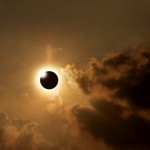
photo credit: Suppakij1017/Shutterstock. A total solar eclipse will be visible from the North Atlantic, and will be seen as partial over Europe
A solar eclipse will occur on March 20 that will be total for some islands in the North Atlantic, while casting Europe into partial darkness.
Solar eclipses occur when the moon gets between the Earth and the sun. If the moon’s orbit was perfectly aligned with that of the Earth, we’d have one every month at the equator. However, the orbits are slightly misaligned. On the downside, that means that most months you’d have to leave the Earth’s surface to be in the right spot to see the sun/moon alignment. On the upside, those events we do get to see occur at different spots on the planet.
This time, the total eclipse will be so hard to get to for most people, it will almost seem like you need to go into space. The only populated places that will witness the moon blocking out the entire sun are the Faroe Islands and Svalbard. Even serious eclipse chasers have balked at the challenges of getting to such remote places, and if you’re thinking you might like to try, you’re probably too late – most hotels, spare rooms and cruise ships sold out long ago.
On the other hand, partial eclipses are visible over a much wider region, in this case all of Europe (clouds permitting) and substantial portions of Africa and Asia. Iceland, having just struggled out of winter, will be plunged back into near total darkness, albeit rather early in the morning. Parts of Scotland will have 94% of the sun blocked out, and even Rome, for example, will lose 60% of its light.
Europe will not experience another total solar eclipse until 2026, while Indonesia will witness one next year and the United States the year after.
Without totality, viewers in most of Europe will miss out on the most spectacular part of an eclipse, which is when the solar corona becomes visible because so much light from the sun itself has been blocked out.
However, for those using proper eclipse glasses (please!), you can still see the moon appear to take a slowly growing bite out of the sun. Using binoculars or a telescope (do we need to stress that this requires really safe filters or a projection onto a screen), this is a great time to check out sunspots as well.
There have been reports that the eclipse could threaten Europe’s power systems since solar production will largely stop at that time. However, while solar power has grown dramatically since the last Europe-wide eclipse in 1999, it represents nothing like the 10% of Europe’s electricity production that has been claimed by supposedly reputable outlets. Moreover, for most of Europe, the effect of the eclipse will be no more intense than heavy cloud coverage, and is far more predictable. The eclipse will start in the early morning when little solar production will be occurring. However, the surge of energy that could come onto the grid as the eclipse finishes could test adaptation capacity.








 Photographer Finds Locations Of 1960s Postcards To See How They Look Today, And The Difference Is Unbelievable
Photographer Finds Locations Of 1960s Postcards To See How They Look Today, And The Difference Is Unbelievable  Hij zet 3 IKEA kastjes tegen elkaar aan en maakt dit voor zijn vrouw…Wat een gaaf resultaat!!
Hij zet 3 IKEA kastjes tegen elkaar aan en maakt dit voor zijn vrouw…Wat een gaaf resultaat!!  Scientists Discover 512-Year-Old Shark, Which Would Be The Oldest Living Vertebrate On The Planet
Scientists Discover 512-Year-Old Shark, Which Would Be The Oldest Living Vertebrate On The Planet  Hus til salg er kun 22 kvadratmeter – men vent til du ser det indvendigt
Hus til salg er kun 22 kvadratmeter – men vent til du ser det indvendigt  Superknepet – så blir snuskiga ugnsformen som ny igen!
Superknepet – så blir snuskiga ugnsformen som ny igen!  Meteorite That Recently Fell in Somalia Turns Out to Contain Two Minerals Never Before Seen on Earth
Meteorite That Recently Fell in Somalia Turns Out to Contain Two Minerals Never Before Seen on Earth  Nearly Frozen Waves Captured On Camera By Nantucket Photographer
Nearly Frozen Waves Captured On Camera By Nantucket Photographer  It’s Official: Astronomers Have Discovered another Earth
It’s Official: Astronomers Have Discovered another Earth 